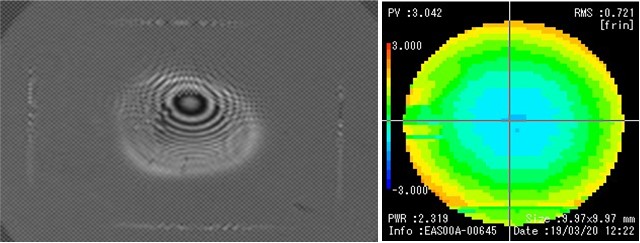Optical thin films are thin films that use the properties of light to control the reflection and transmission of light.
At NDK, this invisible thin film can be coated on various filters, including optical low-pass filters, to prevent reflections, block light in the infrared region, and deposit a variety of other functions.
AR Coating (Antireflection Film)
AR coatings can reduce surface reflection and improve transmittance of optical components.
When the angle is tilted from perpendicular incidence, the reflection increases. Therefore, at NDK, we developed the "Low incident angle-dependent AR coating" that can suppress almost all reflections up to an incident angle of 30° by optimizing and devising the film design. This makes it possible to suppress color irregularities, ghosting, etc.

Right: Without AR Coating

AR Coating Design

Low Incident Angle-dependent AR Coating Design


<Low Incident Angle-dependent AR Coating (Left: Transmittance, Right: Reflectance)>
IR-cut Coating
IR-cut coatings can block out light in the infrared region and allow visible light to pass through.
The spectral characteristics change as the angle is tilted from perpendicular incidence. Therefore, at NDK, we developed the "Low incident angle-dependent IR-cut coating" that can suppress almost all reflections up to an incident angle of 30° by optimizing and devising the film design. This makes it possible to suppress color irregularities, ghosting, etc.
IR-cut Coating Design


<Regular IR-cut Coating (Left: Transmittance, Right: Reflectance)>


<Low Incident Angle-dependent IR-cut Coating (Left: Transmittance, Right: Reflectance)>
Comparison of Characteristics
Angular Dependence of Visible Band Reflection Ripple

Visible band reflection ripple reduced by up to 73%
compared to general design IR-cut coating filters
Angular Dependence of IR Half-value Shift

IR half-value shift reduced by up to 55%
compared to general design IR-cut coating filters
Indium Tin Oxide(ITO)
Indium tin oxide, which is a mixture of indium oxide and tin oxide, is used as a material to form transparent conductive films.
Can be combined with UVIR-cut coatings and AR coatings
Performance example: Sheet resistance 1.15E+05 ΩRS (actual measurement example)
Water Repellent Coating
The final layer of the vapor deposition is coated with a fluorine film.
This treatment improves the surface slipperiness and makes it difficult for foreign matter and dirt to adhere to the surface, and also helps prevent the surface from being scratched.


Reflectance Characteristic Data Before and After Water Repellent Coating

Low Stress Controling Technology
We can provide optical thin films with low stress based on our unique manufacturing methods and design technologies.
The following is an example of the AR coating, but by combining it with the low reflective design, it is possible to deposit AR coatings with low incidence angle dependence, low reflection, and low stress on large sheets and substrates with dimension and thickness of 45 × 35 × 0.2 mm.
Regular AR Coating Design

Reflected Wavefront Image(Regular AR Coating Design)

Low Stress AR Coating Design

Reflected Wavefront Image(Low Stress AR Coating Design)

Optical Component
